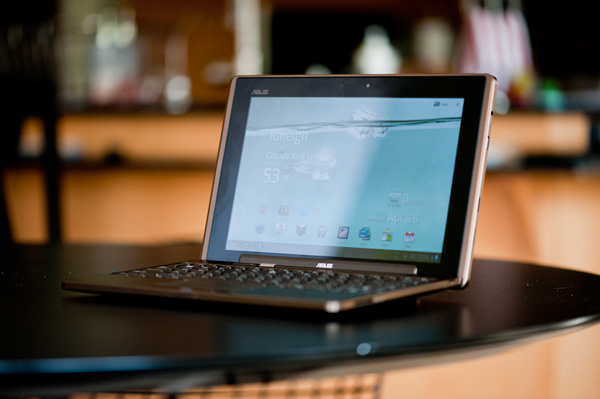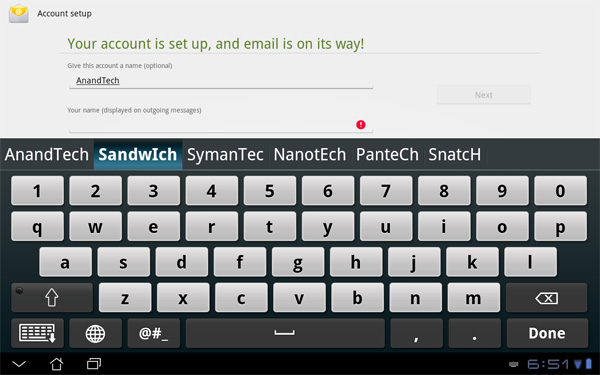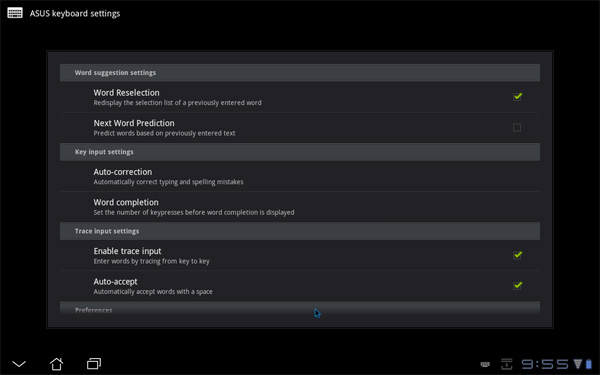ASUS Eee Pad Transformer Review
by Anand Lal Shimpi on April 21, 2011 4:00 AM ESTDock Issues
As impressed as I was with the fact that ASUS took a tablet OS and made it work in both the tablet and notebook worlds, the Eee Pad Transformer dock isn't without its issues. As I alluded to before, there are times when the dock simply doesn't work. I'll be using the dock, scrolling around or typing and then all of the sudden the keyboard and trackpad stop working altogether. Sometimes the solution is as simple as undocking and redocking the Eee Pad, but other times it requires a full reboot. It's frustrating.
I've also encountered a hard lock and an unexpected reboot, both while docked although I'm not sure if ASUS is to blame or if these are Honeycomb specific issues. ASUS tells me that the Transformer docks that were sent out to reviewers are one firmware revision too old, and what will go out to customers next week should have a number of bugs fixed. I expect to have final hardware/software sometime next week, which I'll be testing to see exactly how much has been fixed.
There's also an issue with power consumption. The dock doesn't exactly have an on/off switch, so even when not in use it'll eat up power as it waits to see if you've docked an Eee Pad to it. ASUS expects to address this with a future firmware update for the dock next month. The update will put the unit into an ultra low power state when docked if the tablet is in standby, and power down completely when not attached to the tablet.
ASUS' Virtual Keyboard: By Nuance
If you read our Xoom review you'll know that I was pretty impressed with the stock Honeycomb keyboard. Not only does it boast a clean layout but Google also provides adjustable autocorrect settings, allowing you to configure how aggressive the autocorrect system behaves. Thus I was surprised to find out that the Eee Pad ships with a custom ASUS virtual keyboard:

A little digging reveals that Nuance (the company that makes Dragon NaturallySpeaking) is the ISV that developed the keyboard and its underlying autocorrect engine. Similar to what Apple offers under iOS, Nuance corrects what you type by looking at word length, letters used and proximity of those letters to others on the keyboard. The ASUS keyboard is just as configurable as the stock Android keyboard, even letting you set how aggressive the auto correction engine behaves.
The ASUS virtual keyboard also supports "trace input" which is basically a non-trademarked word for Swype. Trace input on the Eee Pad works but the tracing animation is pretty laggy and I feel like accuracy isn't quite as good as Swype on smartphones.
The look and layout of ASUS' virtual keyboard also differs from the stock Honeycomb keyboard. ASUS includes a row of number keys along the top of the keyboard, without increasing the footprint of the keyboard—meaning all of the keys get shorter. Thankfully on a 10.1-inch screen, even shorter keys aren't that hard to hit, and the addition of the number row saves you an awkward trip to a secondary keyboard screen. The backspace and return keys are unfortunately placed in the very bottom right corner, which I never could get used to.














127 Comments
View All Comments
Shadowmaster625 - Thursday, April 21, 2011 - link
Device synergy is exactly why windows is a must for me. I write all sorts of apps, macros, and scripts that help me get **** done fast and efficient. I can draw a note on my screen, take a screenshot of that note, upload it, get a shortened url for it, and send that url to the computer in my bedroom (and make it automatically open up in its browser) all in a few keystrokes. There aint no way you are ever going to be able to do half of that with an iCRAP or an android. And even if you could, why reinvent the wheel? I did not spend hours writing custom visual C programs and autohotkey scripts just to turn around and be asked to set up all new stuff for some little piece of junk fad. If it cant run my stuff it is useless to me.Shadowmaster625 - Thursday, April 21, 2011 - link
Let's say you have a desktop, a notebook, and a tablet. All have windows and all have a dropbox mapped to drive S: So I create files called "linkshareMain.txt","linkshareTablet.txt", etc. And on each device I have running in the background a program that reads those files parses out urls and opens each url in a new browser tab. So if I want to send this article to my notebook I just click on my desktop shortcut called "linkshare Notebook.txt" and paste http://www.anandtech.com/show/4277/asus-eee-pad-tr... and then save&close. Soon as my notebook is awake it gets that link and opens it and deletes that link from the file.I can also do the same thing using email. I just have a program that parses through all incoming email searching for keywords like: launch_urls_nb625: and then it treats all following lines of text as urls and opens them. Can also launch other programs, load pdf files, play videos, etc. So if I am at work and I want to read this article when I get home I just send myself an email saying launch_urls_main625: http://www.anandtech.com/show/4277/asus-eee-pad-tr... and this article comes up as soon as I wake my computer.
It is fairly easy to set this kind of stuff up, and I will not migrate to a new OS or architecture unless they give me, the end user, this kind of control.
leonzio666 - Friday, April 22, 2011 - link
Hey, could you please specify what program reads and parses the text file in the background? I find this method of yours very interesting and would like to give it a try.seapeople - Sunday, April 24, 2011 - link
Wow, if I want to transfer links between computers I would just bookmark it and Xmarks does the rest. That's like one click.But it's good that you know how to do all that stuff the hard way; we'll need people like you if the internet breaks.
Shadowmaster625 - Monday, April 25, 2011 - link
Yeah well when you deal with a lot of news articles and all sorts of random stuff, bookmarks quickly become impracticle. I have seen many a bookmarks/favorites page that will scroll down for miles and miles. I find that sort of thing unacceptable. I never bookmark a page I will most likely only visit once.jnmfox - Thursday, April 21, 2011 - link
Sounds like a character from Wall-Edaoist - Thursday, April 21, 2011 - link
Anand,Sorry to be pedantic about this, but everyone is really worried.
Can you confirm that the GPS hardware works without wifi connected?
Does the GPS turn on and get a signal even if your wifi is off?
I understand that some apps (e.g. Google Maps) require a Wifi Connection to receive *data*, but does the Transformer require wifi to be connected to receive *GPS* signal?
Could you download a GPS app which doesn't need data (GPS Status works) and confirm it works? https://market.android.com/details?id=com.eclipsim...
Thanks for the in-depth review and for putting up with the GPS nonsense :)
daoist - Thursday, April 21, 2011 - link
That is, use GPS status with the Wifi Off, I meant. :)lobo4123 - Thursday, April 21, 2011 - link
I'd like to see IR transmitters integrated into tablets and cellphones. They may be archaic, but it would be nice to be able to use an android device as a universal remote.flashbacck - Thursday, April 21, 2011 - link
Are the performance issues in honeycomb something that needs to be fixed with quad core processors? I feel like that's throwing raw horsepower at a problem that should be fixed with better programming.